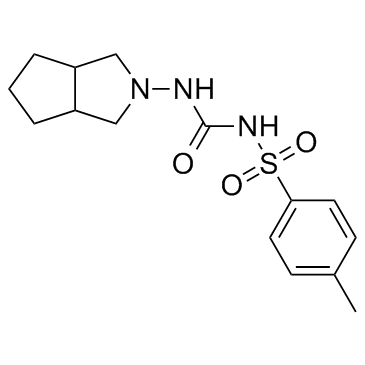| Cas No.: | 21187-98-4 |
| SMILES: | O=C(NS(C1=CC=C(C)C=C1)(=O)=O)NN2CC(CCC3)C3C2 |
| Formula: | C15H21N3O3S |
| M.Wt: | 323.41 |
| Purity: | >98%, Standard References Grade |
| Sotrage: | 4°C for 1 year, -20°C for more than 2 years |
| Description: | Gliclazide is a whole-cell beta-cell ATP-sensitive potassium currents blocker with an IC50 of 184 nM.Target: Potassium Channelgliclazide further characterize its mechanism of hypoglycemic effect: the observed improvements in insulin sensitivity and in GLUT4 translocation indicate that gliclazide counters the hydrogen peroxide-induced insulin resistance in 3T3L1 adipocytes and also would further augment the hypoglycemic effect of this drug as insulinotropic sulfonylurea [1]. Gliclazide blocked whole-cell beta-cell KATP currents with an IC50 of 184 +/- 30 nmol/l (n = 6-10) but was much less effective in cardiac and smooth muscle (IC50s of 19.5 +/- 5.4 micromol/l (n = 6-12) and 37.9 +/- 1.0 micromol/l (n = 5-10), respectively). In all three tissues, the action of the drug on whole-cell KATP currents was rapidly reversible. In inside-out patches on beta-cells, gliclazide (1 micromol/l) produced a maximum of 66 +/- 13 % inhibition (n = 5), compared with more than 98 % block in the whole-cell configuration. Gliclazide is a high-potency sulphonylurea which shows specificity for the pancreatic beta-cell KATP channel over heart and smooth muscle. In this respect, it differs from glibenclamide [2]. |
| References: | [1]. Shimoyama, T., et al., Gliclazide protects 3T3L1 adipocytes against insulin resistance induced by hydrogen peroxide with restoration of GLUT4 translocation. Metabolism, 2006. 55(6): p. 722-30. [2]. Lawrence, C.L., et al., Gliclazide produces high-affinity block of KATP channels in mouse isolated pancreatic beta cells but not rat heart or arterial smooth muscle cells. Diabetologia, 2001. 44(8): p. 1019-25. |

 DC Chemicals' products qualify for U.S. tariff exemptions. We guarantee no price increases due to customs duties and maintain stable supply, continuing to deliver reliable research solutions to our American clients.
DC Chemicals' products qualify for U.S. tariff exemptions. We guarantee no price increases due to customs duties and maintain stable supply, continuing to deliver reliable research solutions to our American clients.





















